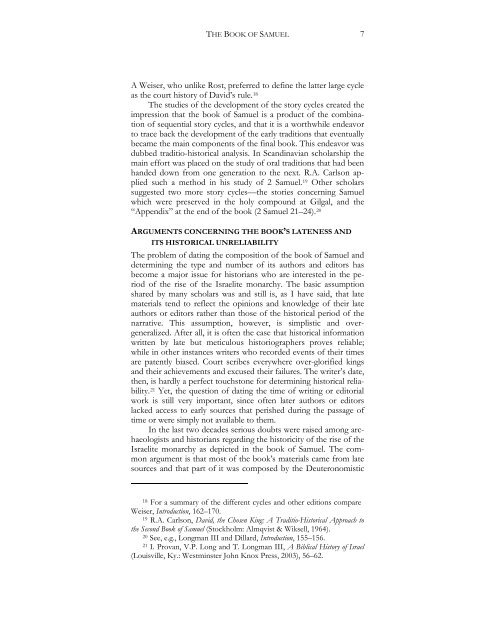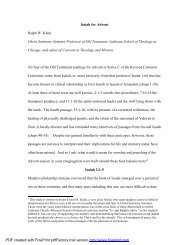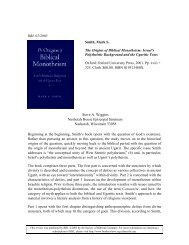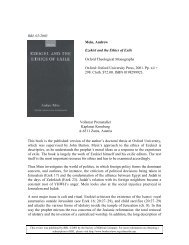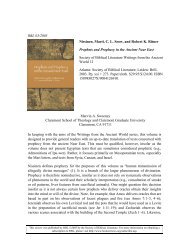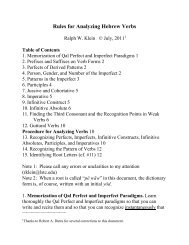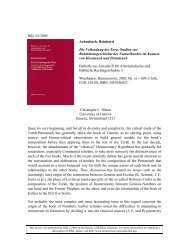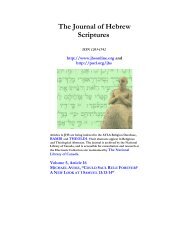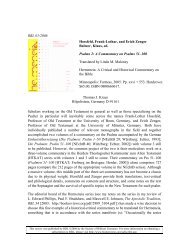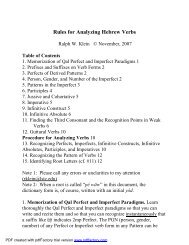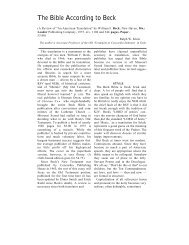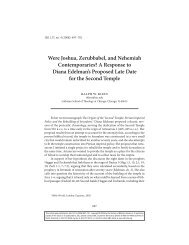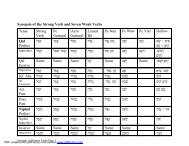The Book of Samuel: Its Composition, Structure and Significance as ...
The Book of Samuel: Its Composition, Structure and Significance as ...
The Book of Samuel: Its Composition, Structure and Significance as ...
Create successful ePaper yourself
Turn your PDF publications into a flip-book with our unique Google optimized e-Paper software.
THE BOOK OF SAMUEL<br />
A Weiser, who unlike Rost, preferred to define the latter large cycle<br />
<strong>as</strong> the court history <strong>of</strong> David’s rule. 18<br />
<strong>The</strong> studies <strong>of</strong> the development <strong>of</strong> the story cycles created the<br />
impression that the book <strong>of</strong> <strong>Samuel</strong> is a product <strong>of</strong> the combination<br />
<strong>of</strong> sequential story cycles, <strong>and</strong> that it is a worthwhile endeavor<br />
to trace back the development <strong>of</strong> the early traditions that eventually<br />
became the main components <strong>of</strong> the final book. This endeavor w<strong>as</strong><br />
dubbed traditio-historical analysis. In Sc<strong>and</strong>inavian scholarship the<br />
main effort w<strong>as</strong> placed on the study <strong>of</strong> oral traditions that had been<br />
h<strong>and</strong>ed down from one generation to the next. R.A. Carlson applied<br />
such a method in his study <strong>of</strong> 2 <strong>Samuel</strong>. 19 Other scholars<br />
suggested two more story cycles—the stories concerning <strong>Samuel</strong><br />
which were preserved in the holy compound at Gilgal, <strong>and</strong> the<br />
“Appendix” at the end <strong>of</strong> the book (2 <strong>Samuel</strong> 21–24). 20<br />
ARGUMENTS CONCERNING THE BOOK’S LATENESS AND<br />
ITS HISTORICAL UNRELIABILITY<br />
<strong>The</strong> problem <strong>of</strong> dating the composition <strong>of</strong> the book <strong>of</strong> <strong>Samuel</strong> <strong>and</strong><br />
determining the type <strong>and</strong> number <strong>of</strong> its authors <strong>and</strong> editors h<strong>as</strong><br />
become a major issue for historians who are interested in the period<br />
<strong>of</strong> the rise <strong>of</strong> the Israelite monarchy. <strong>The</strong> b<strong>as</strong>ic <strong>as</strong>sumption<br />
shared by many scholars w<strong>as</strong> <strong>and</strong> still is, <strong>as</strong> I have said, that late<br />
materials tend to reflect the opinions <strong>and</strong> knowledge <strong>of</strong> their late<br />
authors or editors rather than those <strong>of</strong> the historical period <strong>of</strong> the<br />
narrative. This <strong>as</strong>sumption, however, is simplistic <strong>and</strong> overgeneralized.<br />
After all, it is <strong>of</strong>ten the c<strong>as</strong>e that historical information<br />
written by late but meticulous historiographers proves reliable;<br />
while in other instances writers who recorded events <strong>of</strong> their times<br />
are patently bi<strong>as</strong>ed. Court scribes everywhere over-glorified kings<br />
<strong>and</strong> their achievements <strong>and</strong> excused their failures. <strong>The</strong> writer’s date,<br />
then, is hardly a perfect touchstone for determining historical reliability.<br />
21 Yet, the question <strong>of</strong> dating the time <strong>of</strong> writing or editorial<br />
work is still very important, since <strong>of</strong>ten later authors or editors<br />
lacked access to early sources that perished during the p<strong>as</strong>sage <strong>of</strong><br />
time or were simply not available to them.<br />
In the l<strong>as</strong>t two decades serious doubts were raised among archaeologists<br />
<strong>and</strong> historians regarding the historicity <strong>of</strong> the rise <strong>of</strong> the<br />
Israelite monarchy <strong>as</strong> depicted in the book <strong>of</strong> <strong>Samuel</strong>. <strong>The</strong> common<br />
argument is that most <strong>of</strong> the book’s materials came from late<br />
sources <strong>and</strong> that part <strong>of</strong> it w<strong>as</strong> composed by the Deuteronomistic<br />
18 For a summary <strong>of</strong> the different cycles <strong>and</strong> other editions compare<br />
Weiser, Introduction, 162–170.<br />
19 R.A. Carlson, David, the Chosen King: A Traditio-Historical Approach to<br />
the Second <strong>Book</strong> <strong>of</strong> <strong>Samuel</strong> (Stockholm: Almqvist & Wiksell, 1964).<br />
20 See, e.g., Longman III <strong>and</strong> Dillard, Introduction, 155–156.<br />
21 I. Provan, V.P. Long <strong>and</strong> T. Longman III, A Biblical History <strong>of</strong> Israel<br />
(Louisville, Ky.: Westminster John Knox Press, 2003), 56–62.<br />
7


